Ch. 11 MEIOSIS AND SEXUAL REPRODUCTION
1/41
There's no tags or description
Looks like no tags are added yet.
Name | Mastery | Learn | Test | Matching | Spaced |
|---|
No study sessions yet.
42 Terms
Somatic Cell
any body cell that is not a reproductive (sex) cell.
These cells make up most of an organism’s body—like your skin, muscles, bones, and organs.
Somatic cells contain two complete sets of chromosomes (one set from each parent), making them diploid (2n)
Gamete cells
reproductive cells (sperm or egg) that each carry half the genetic information needed to make a new organism.
haploid, only one set of chromosomes
fertilization
where two gametes (egg and sperm) join together to form a zygote, which is the first cell of a new organism.
Zygote
first cell formed when a sperm cell from the father fuses with an egg cell from the mother during fertilization.
It is a diploid cell (2n) because it has two sets of chromosomes — one from each parent
Diploid (2n)
Cells with two sets of chromosomes—one from each parent.
Example: human body (somatic) cells have 46 chromosomes.
Haploid (1n)
Cells with one set of chromosomes.
Example: human gametes (egg & sperm) have 23 chromosomes.
Homologous Chromosomes
pairs of chromosomes that have the same genes in the same order, but may have different versions of those genes (alleles)
One chromosome in the pair comes from each parent, and they are matched by size, shape, and the location of their centromere.
They are essential for sexual reproduction because they separate during meiosis to create haploid cells (sperm or egg).
Sexual Reproduction
Involves two haploid cells that fuse to create a genetically unique diploid cell.
This method is characterized by meiosis (a type of cell division that generates haploid gametes) and fertilization.
Introduces genetic variation critical for evolutionary success.
Most eukaryotic organisms reproduce using meiosis and fertilization.
The Process of Meiosis
type of cell division that occurs in sexually reproducing organisms to produce gametes (sperm and egg cells).
It reduces the number of chromosomes in half—from diploid (2n) to haploid (1n)—so when fertilization occurs, the resulting zygote has the correct diploid number of chromosomes. This prevents chromosome doubling in each generation
Consists of:
One round of chromosome/DNA replication.
Two rounds of nuclear division (Meiosis I & II).
Occurs in germ cells (not somatic cells)
. Produces 4 genetically unique haploid cells
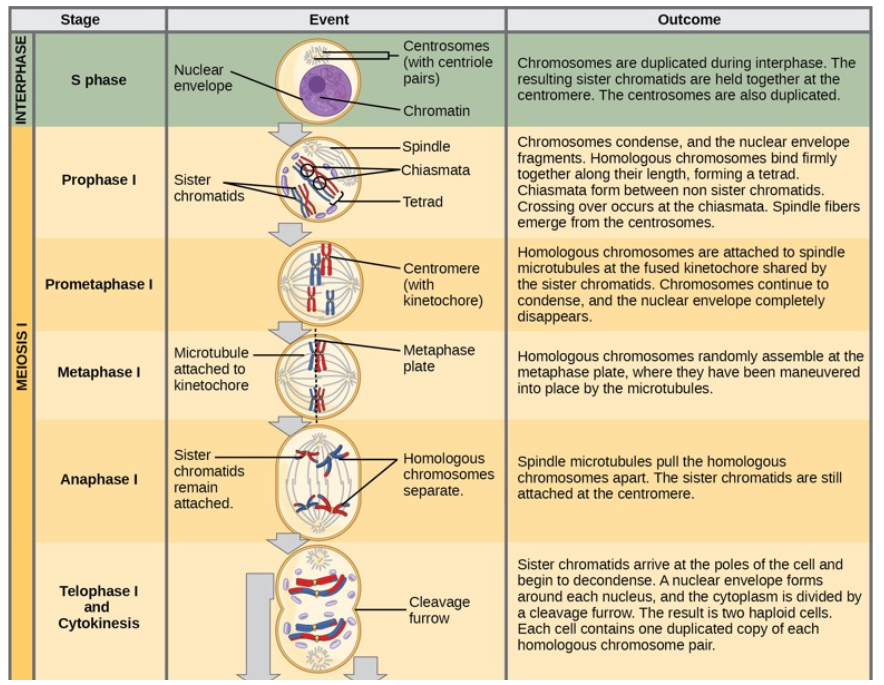
Meiosis I
(Reduction Division)
First meiotic division that reduces chromosome number by half, separating homologous chromosomes into two haploid cells.
a single diploid cell divides into two haploid cells, reducing the chromosome number by half.
This process involves homologous chromosomes pairing up and exchanging genetic material through crossing over (in prophase I), lining up at the cell's equator (in metaphase I), and then separating to opposite poles of the cell (in anaphase I)
Chiasmata
(singular, chiasma) the structure that forms at the crossover points after genetic material is exchanged
Cohesin complex
protein that holds sister chromatids together until they are pulled apart during cell division during prophase I
Prophase I
Homologous chromosomes pair up (this is the only time they do).
They exchange pieces through crossing over, which creates genetic variety.
The nucleus breaks down and spindle fibers form.
Homologous Chromosomes Pair Up (Synapsis):
Homologous Chromoomes pair up with each other . They line up and are held together by a structure called the synaptonemal complexCrossing Over Occurs:
The nonsister chromatids (one from each homologous chromosome) swap segments of DNA.
The points where this exchange happens are called chiasmata.
The result is new combinations of genes, increasing genetic diversity
Formation of Tetrads:
Each paired set of homologous chromosomes (with four chromatids total) is called a tetrad. These structures are visible under a microscopeBreakdown of Synaptonemal Complex:
As Prophase I ends, this protein structure disappears, but the homologous chromosomes stay attached at the chiasmata until they separate in the next stage

Synapsis
process in meiosis where homologous chromosomes pair up and align closely, forming a tetrad or bivalent structure.
Synaptonemal Complex
protein structure that forms between homologous chromosomes during Prophase I of meiosis to hold them tightly together.
tetrad
group of four chromatids formed when two homologous chromosomes pair up (held together by chiasmata) during Prophase I of meiosis.
crossing over
the exchange of DNA between homologous chromosomes during Prophase I, creating genetic diversity
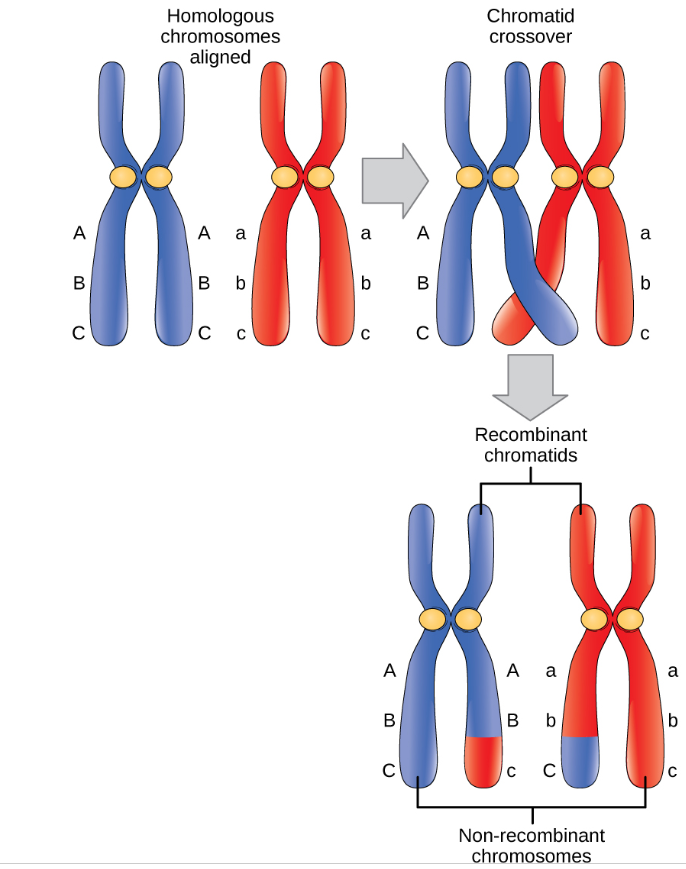
2.Prometaphase I
Nuclear envelope is completely gone.
Spindle fibers attach to each homologous chromosome.
Pairs of homologous chromosomes start moving toward the middle.
second stage of meiosis I
Nuclear Membrane Breaks Down:
The nuclear envelope dissolves completely, freeing the chromosomes into the cytoplasm
Spindle Fibers Attach to Chromosomes:
Microtubules (spindle fibers) grow from opposite ends of the cell and attach to kinetochore proteins on each chromosome’s centromere.
Each homolog in the pair attaches to spindle fibers from opposite poles of the cell
Chromosomes Still Connected at Chiasmata:
Even though the nuclear envelope is gone, the homologous chromosomes remain connected at the chiasmata, where crossing over occurred in prophase I
• Spindle fiber microtubules attach to the kinetochore proteins at the centromeres
• Homologs still held together at chiasmata
UK• Nuclear membrane is completely broken down

Metaphase I
Homologous pairs line up side-by-side in the middle of the cell.
Not single file like in mitosis.
(Think two-by-two.)
3rd stage of meiosis I, where the paired homologous chromosomes (tetrads) line up in the middle of the cell along an imaginary line called the metaphase plate.
Homologous chromosomes are arranged at the cell equator with kinetochores facing opposite poles
Maternal and paternal chromatids orient randomly and are mixed when they migrate to the poles
This creates additional genetic variation among daughter cells

Anaphase I
The homologous chromosomes get pulled away from each other to opposite sides.
Sister chromatids stay together
The microtubules pull tetrads apart
Chiasmata are broken but sister chromatids remain attached at centromere

Telophase I and Cytokinesis
• Separated chromosomes arrive at opposite poles
• If cytokinesis (separation of cytoplasmic contents into daughter cells) does occur, nuclei do not reform
-Two haploid cells with one of each homologous chromosome.

Telophase I
where separated homologous chromosomes arrive at opposite poles of the cell, and the cell divides into two haploid daughter cells.
The cell starts to split.
Two nuclei may reform, and the cell divides.
Cytokinesis
The cell fully separates into two haploid cells (each has half the chromosome number, but chromosomes are still duplicated).
✂ Cytoplasm Splits:
The cell’s cytoplasm divides, forming two new haploid daughter cells.
Each contains one set of chromosomes, still made up of sister chromatids
Ch. 11 Meiosis and Sexual Repro…
.
🌱 How Division Happens:
In animal cells, a cleavage furrow (pinching in of the cell membrane) separates the two cells.
In plant cells, a cell plate forms between the two nuclei, which later develops into a new cell wall
division in animal cells
a cleavage furrow (pinching in of the cell membrane) separates the two cells.
division in plant cells
form a cell plate that ultimately produces cell walls that separate the daughter cells
Meiosis II
Similar to Mitosis but in haploid cells
second part of meiosis, where the two haploid cells from meiosis I divide again to form four genetically unique haploid cells.
involves separation of sister chromatids:
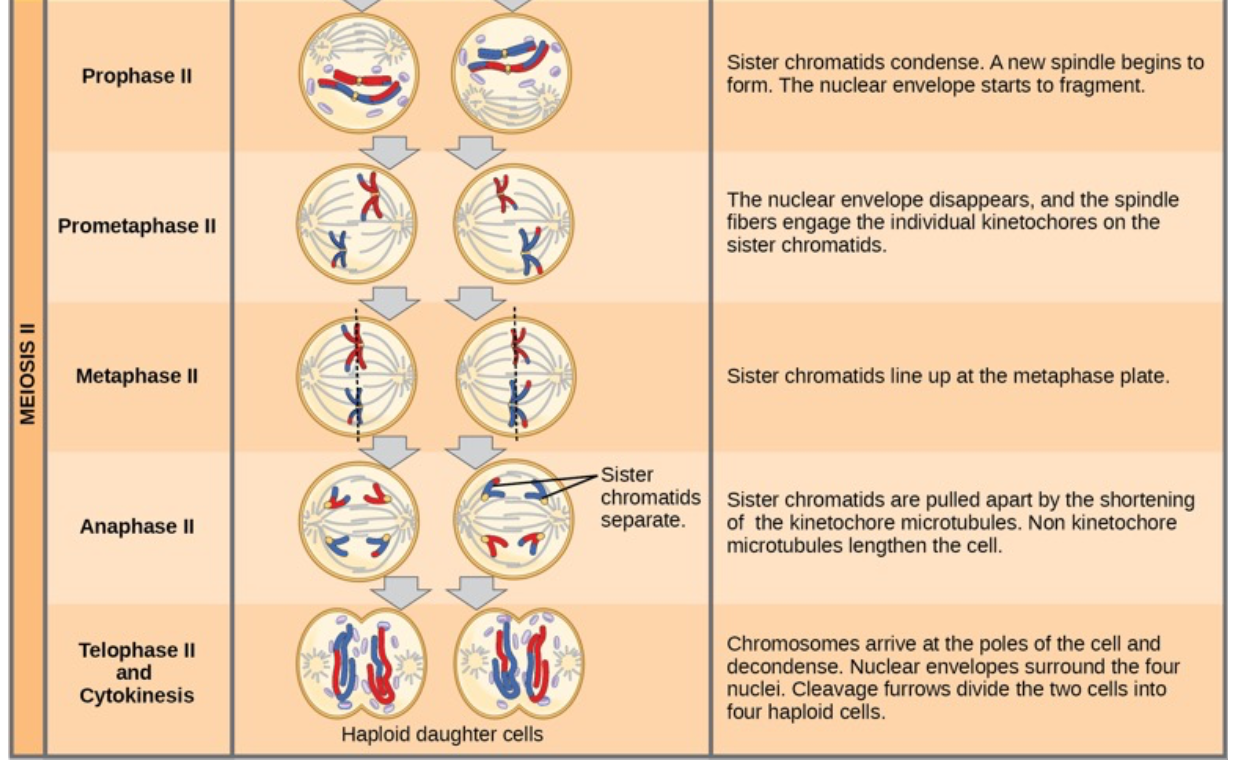
1. Prophase II
first stage of Meiosis II, which starts after the first cell division of meiosis (Meiosis I).
Chromosomes condense again if they had uncoiled after meiosis I.
The nuclear envelope (if it reformed) breaks down.
New spindle fibers form in each haploid cell.
Spindle fibers form and start moving the chromosomes toward the middle of the cell.
The centrosomes move to opposite poles

2. Prometaphase II
The nuclear envelope completely breaks down (if it had reformed after Meiosis I).
Spindle is fully formed
Spindle fibers attach to the kinetochores of each sister chromatid on opposite sides of the centromere

3. Metaphase II
Sister chromatids line up single-file at the metaphase plate (middle of the cell).
This arrangement is similar to mitosis, but the cells are haploid, not diploid
Spindle fibers from opposite poles attach to the kinetochores of each chromatid.
This ensures that, when the chromatids separate in the next phase, each new cell will get one complete set of chromosomes.

4. Anaphase II
fourth stage of Meiosis II, where the sister chromatids finally separate and move to opposite sides of the cell.
The sister chromatids separate at the centromere and move toward opposite poles of the cell.
Each chromatid is now considered an individual chromosome
The cell elongates to prepare for division

5. Telophase II and Cytokinesis
Chromosomes reach the poles and decondense.
Nuclear envelopes reform, and cytokinesis divides the cytoplasm.
The result is four unique haploid cells, each with one complete set of chromosomes

Telophase II:
The chromosomes reach opposite poles of the cell and begin to uncoil (decondense).
Nuclear envelopes form around each set of chromosomes, creating four separate nuclei.
Cytokinesis:
The cytoplasm divides, splitting each cell into four haploid cells.
In total, meiosis produces four haploid (1n) daughter cells, each with half the original chromosome number and unique genetic combinations.
Comparing Meiosis to Mitosis
Both processes divide the nucleus in eukaryotic cells
Mitosis is a single division; meiosis has two
Homologous chromosomes pair to form tetrads in meiosis but not in mitosis
In meiosis, crossing over between sister chromatids and random assortment of chromosomes in anaphase I create genetic variation – mitosis produces genetically identical clones
Meiosis reduces ploidy (2n → 1n), mitosis does not
Mitosis:
Produces two genetically identical diploid cells.
2 # of daughter cells
somatic cells (body cells)
is a singular division
growth, repair, development
Meiosis:
Results in four genetically distinct haploid cells; involves crossover and independent assortment during Meiosis I.
two rounds of division
4 # of daughter cells
germline cells
produce gametes cells (sperm and eggs)
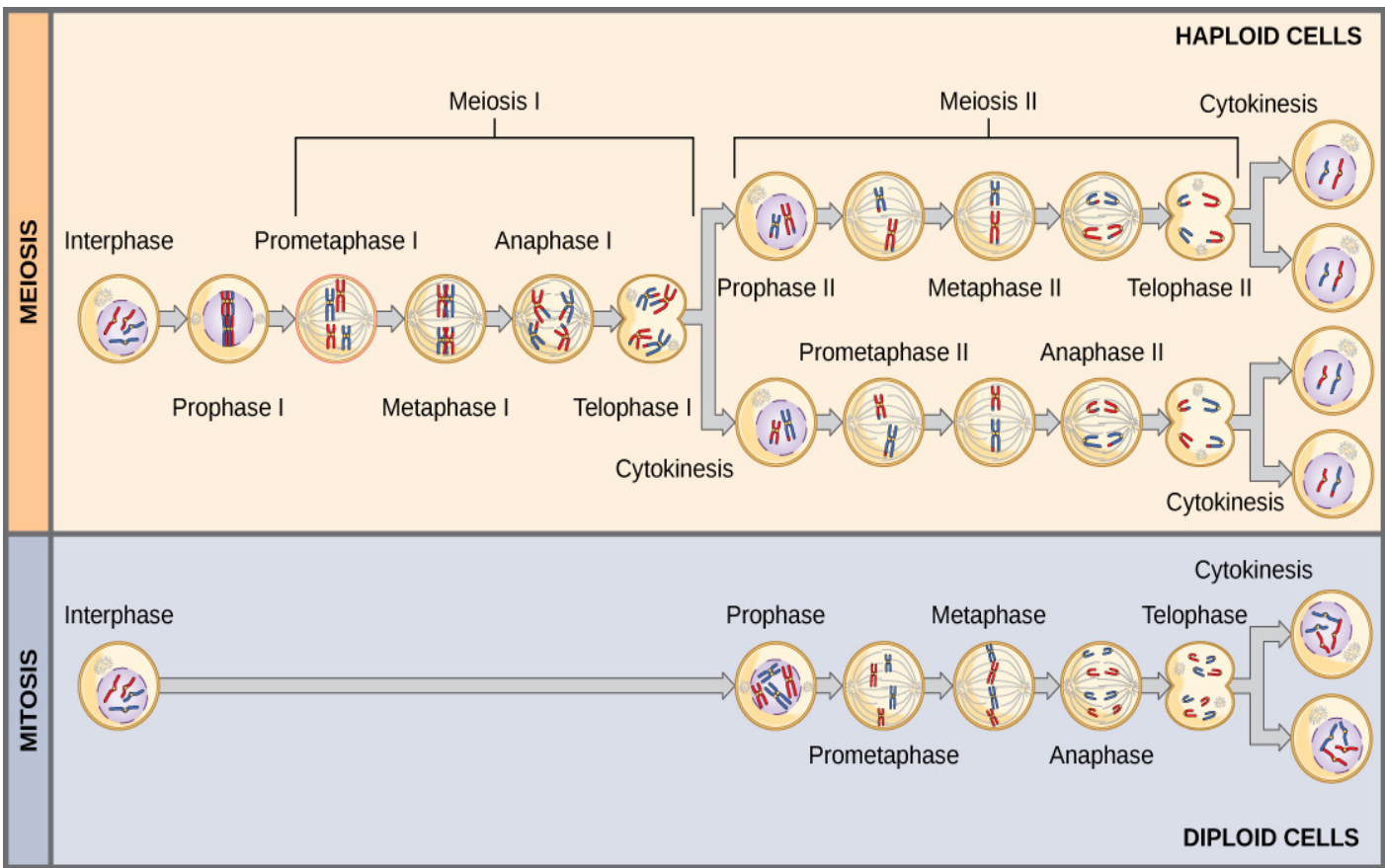
Evolution of Meiosis
A. Likely evolved from mitosis
-For meiosis to evolve, several important steps had to occur:
Pairing of homologous chromosomes (synapsis) — allowed chromosomes from each parent to align.
Crossing over — created genetic variation by exchanging DNA between homologs.
Sister chromatids staying together during Anaphase I — prevented premature separation.
Suppression of DNA replication between divisions — ensured chromosome number was reduced by half.
These steps transformed mitosis (which produces identical cells) into meiosis (which produces genetically diverse haploid cells).clues
3 main categories of life cycles in multicellular organisms
– Diploid-dominant
– Haploid-dominant
– Alternation of generations
Diploid-Dominant Life Cycle
Animals produce haploid gametes from diploid germ cells.
Meiosis creates gametes in gonads
There is no multicellular haploid life stage
Fertilization occurs when 2 gametes fuse to restore the diploid state
Germ Cells
specialized cell line that produces gametes, such as eggs or sperm
Haploid-Dominant Life Cycle
Some fungi and algae function predominantly as haploid organisms.
Haploid Stage is Dominant:
The “body” of the organism is haploid (1n).
It grows and divides by mitosis to form a multicellular haploid organism.
Two Haploid Cells Fuse to Form a Diploid Zygote:
During sexual reproduction, two haploid cells of opposite mating types (+ and –) join to form a diploid zygote (2n) which immediately undergoes meiosis to form 4 haploid spores
3. Diploid Zygote Quickly Undergoes Meiosis:
The zygote divides by meiosis, producing haploid spores.
These spores grow into new multicellular haploid organisms, completing the cycle
4. Genetic Variety Comes from Meiosis:
Although the spores are haploid, they contain a new genetic mix from both parents.
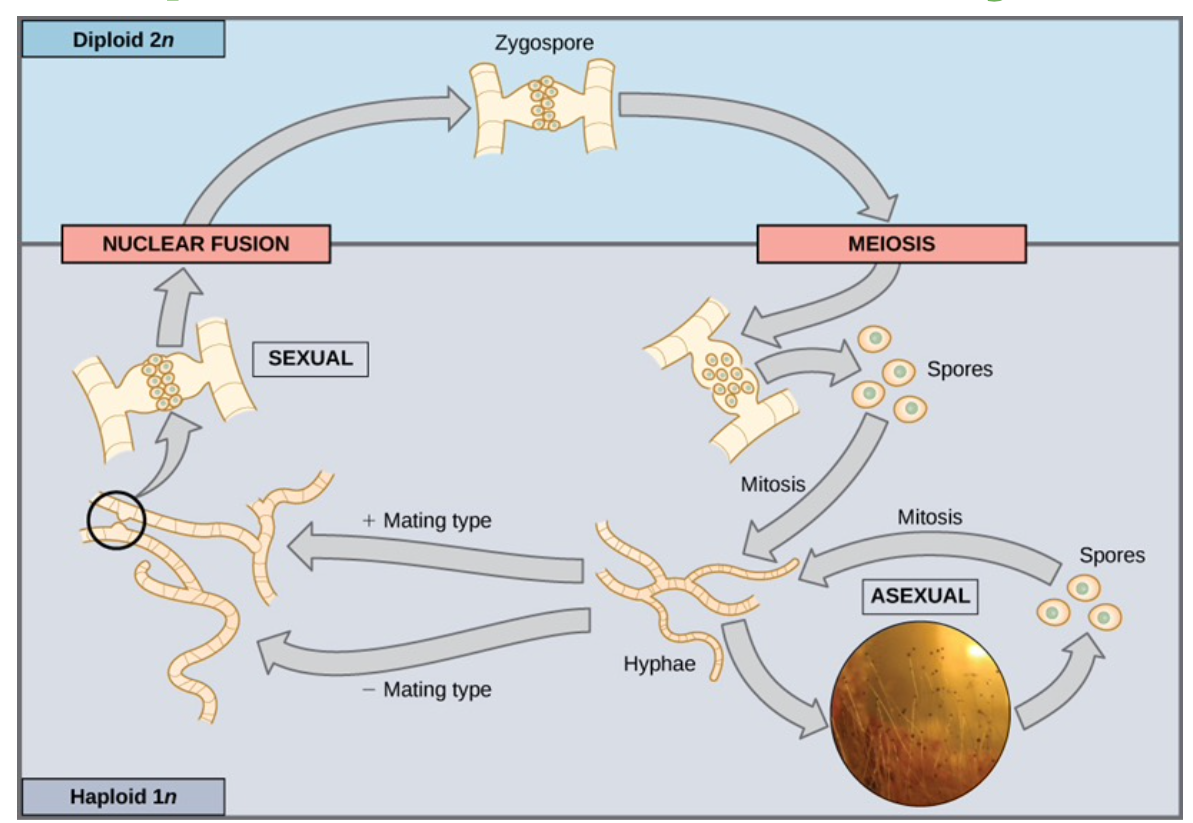
Alternation of Generations
Seen in plants, where both haploid and diploid multicellular stages occur.
a type of life cycle in which an organism alternates between two multicellular stages:
A haploid (1n) gametophyte stage that produces gametes (sex cells) through mitosis.
A diploid (2n) sporophyte stage that produces spores by meiosis.
This life cycle is found in plants and some algae
Meiosis is not directly involved in the production of gametes because the organism that produces the gametes is already a haploid
🔄 Cycle of Reproduction:
The two stages alternate each generation — one haploid, one diploid.
This alternation maintains genetic diversity and stable chromosome numbers over generations.
🌾 Meiosis and Fertilization:
Meiosis happens in the sporophyte to make spores.
Fertilization happens between gametes from the gametophyte to make a zygote (which grows into the sporophyte).
Specialized cells of the sporophyte undergo meiosis to produce haploid spores which subsequently develop into the gametophytes

Gametophyte
a multicellular haploid life-cycle stage that produces gametes
(Haploid, 1n):
Produces gametes (sperm and egg) through mitosis.
When gametes fuse, they form a diploid zygote.
Sporophyte
a multicellular diploid life-cycle stage that produces haploid spores by meiosis
(Diploid, 2n):
Grows from the zygote through mitosis.
Produces haploid spores through meiosis, which develop into new gametophytes